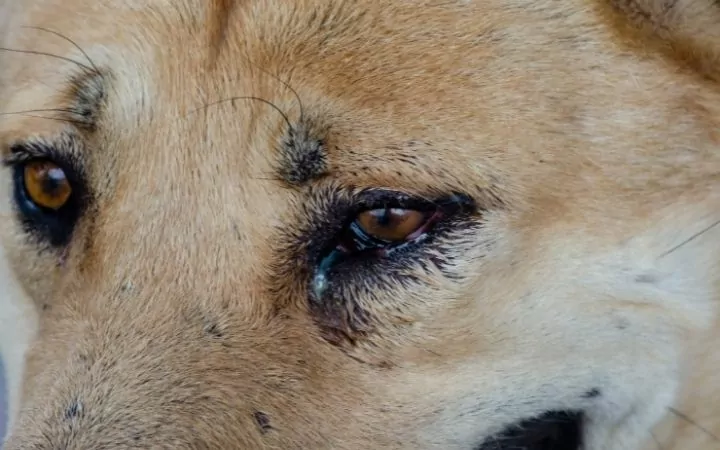Do Dogs Cry Tears?
All your questions answered about do dogs cry tears. The human emotional affiliation with tears is either of extreme happiness, deep sadness, pain, frustration, or even anger sometimes. Even though they produce tears, do dogs cry with the same emotional affiliations?

Although they are incredibly sentient beings that we sometimes project our feelings onto, dogs do not cry tears; they simply produce them for functional and not emotional purposes.
Why Does My Dog Have Watery Eyes Then?
Lacrimation is the term used to describe the production of tears. Tears are actually functional components of the eye produced by the lacrimal glands and distributed by gravity, the third eyelid, and blinking.
Tears have a long list of interesting functions that help keep the eye healthy and protected. Some of the functions include:
- Providing lubrication for the eyelids.
- Limiting evaporation of the lipid layer of the eye.
- Continuously flushing bacteria and foreign material from the surface of the eye.
- Supplying the cornea with nutrients, including oxygen, amino acids, vitamin A, growth factors, removing metabolic waste products, and providing a transport medium for white blood cells to reach the surface of the eye
When there is a malfunction in one of these processes or the eye becomes adversely affected by an external influence–then your dog may appear to have watery eyes. The excessive production of tears is how the body tries to flush out a problem in the eye and is a programmed physiological response, not an emotional one!

Underlying reasons why your dog may have excessive tear production may include:
Conjunctivitis
Conjunctivitis is a term used to describe the inflammation of the inner lining of the eyelids – the causes of the inflammation could be infectious or traumatic. The overproduction of tears is the body’s way of healing and eradicating the source of inflammation or infection.
The tears may cause a build of dirt or matting of hair at the inner corner of the eyes that, if left untreated, can cause moist dermatitis. This is due to the chronic moistness of the area and can be very irritating or cause staining of the inner corner of the eye.
Allergies
Allergies result in the release of histamines due to the body overreacting to an allergen. This results in chronic tearing due to inflammation caused by the allergen. Antihistamines or allergy eye drops usually remedy chronic tearing.
Foreign Body
If a foreign object such as hair, grass seeds, or dust, for example, land on the eye’s surface, it causes irritation, leading to the increased production of tears to flush the irritation out.
If the foreign material is lodged within the cornea, the tears will not flush it out, and a vet visit will be done in order to determine the next course of action.
Blocked Tear Glands (Epiphora)
The insufficient drainage of tears from the tear ducts results in the chronic spilling of tears from the eyes, known as epiphora. Certain small breed or “flat-faced” breed dogs with small nasolacrimal ducts are predisposed to this condition.
The causes can be a wide variety of reasons, and it is best diagnosed by a vet with possibly light sedation to evaluate the eye completely.
Corneal Ulceration
A corneal ulcer is a term used to describe an injury to the corneal layer of the eye. The cornea is very sensitive and can be very painful. A fluoroscene test is used to diagnose and grade a corneal ulcer. Then, your vet will try to determine the cause and find the best treatment option for the condition.
There are a few other reasons for excessive tear production, and it is always best to discuss them with your veterinarian.
How Do Dogs Show Sadness And Pain?
Dogs can show their emotional states in subtle ways and other more obvious ways. Still, their behavior must always be regarded as a window into their emotional wellbeing.
Sadness in dogs can have a variety of forms, but some clues may include:
- Depressed appetite.
- Lack of interest in activities or unwillingness to play.
- Waiting in front of a door or gate.
- Lying on a familiar favorite most-frequented post like a bed or chair for extended periods of time
- Withdrawing from the other pets or the family group.
- Vocalization–unprovoked and usually produced when alone in a room or at a doorway.
Pain in dogs is not always vocalized, but when it is, it depends on the cause, the chronicity, and the severity. For example, sharp yelps often indicate sudden onset pain, whereas groaning and whining indicate unrelenting pain.
Some breeds are more sensitive than others and will vocalize at even the slightest unsettling or possibly painful experience. In contrast, others are stoic and show little to no signs as a preservative instinct. Pain can also elicit unexpected bites, so always approach a painful dog with caution.
Signs of pain can include the following:
- Increased, shallow breathing.
- Reluctance to move or use affected painful area.
- Withdrawal from the family group or other pets.
- Increased aggression towards other pets or family members.
- Weightloss.
Some Information on Canine Emotions
Canine emotions have a very big range, and each dog has its own individual range depending on several factors such as past experiences, nature, breed predisposition as well as general well-being.
Neuroscientists have mapped responses to stimuli in MRI machines, and dogs have exhibited several cues that confirm that dogs have emotion but are challenging to demonstrate scientifically.
Their emotions can be validated because dogs can respond to emotional cues, recognize facial and vocal expressions, and respond to odors in their limbic reward regions of the brain.
There is still a significant amount of research to be conducted into the canine emotional spectrum. Still, the first step in recognizing their value is in acknowledging their significance in animal behavior.
Do Dogs Respond to Our Tears as Humans?
Dogs can exhibit empathy to humans and are also capable of responding to our tears as humans. The difference is often in a dog’s nature regarding how they will respond–just as it is in humans.
Dogs are sentient, and depending on your pet’s nature, their response to your tears will differ. Some pets, for example, will seek more attention or comfort their owners when their owners are crying.
Some may begin to cry out as well, and others may exhibit paradoxical excitement like some awkward humans who make jokes to try and cheer you up when you are upset.
12 Reasons Why Your Dog Might Be Howling
- Stress or anxiety
Dogs use vocalization to alleviate or express their emotional states of stress or anxiety. We often see this in small breed or very vocal dog breeds that are highly strung. The dog may also exhibit attention-seeking behavior or demand to be picked up or hugged to remove themselves from the current stressor or environment.

- Assurance-seeking behavior
A dog will try to become more confident by seeking assurance from its owners to be more comfortable in social situations. However, if your dog constantly seeks your validation and becomes fearful in new situations, an animal behaviorist may be needed.
- Separation anxiety
Some dogs use their vocalization to get their owners’ attention due to separation anxiety. This is often frustrating and can lead to owners’ reluctance to leave their pets at home because they become distraught and disruptive to neighbors.
This behavior is best discussed with a behaviorist as it can become destructive and debilitating to an owner/pet relationship.
- Pain
Pets can vocalize their pain through howling, but it is usually circumstantial–short sharp cries for acute pain, long lamenting cries for prolonged pain, and low moaning whimpers for chronic pain.
- Attention
Dogs use their voices to get their owner’s attention, just as owners use whistles or calls to get their pet’s attention. This is one of the perks of domestication, but it can be overwhelming if your pet only associates howling with getting attention.
- Age-related dementia
Sometimes conditions such as canine cognitive dysfunction can leave pets feeling overwhelmed, disorientated, or suddenly anxious, just like elderly people feel who suffer from dementia.
- Excitement
Pets who howl when excited are often positively reinforced by their owners or other pets, so they learn to associate howling with excitement.
- An invitation
Just as in the wild, dogs would use their voices to communicate invitations to other pack members. It also grabs the attention of an owner, and it may be misconstrued as when “I howl my owner returns home sooner.”
- Setting boundaries
Dogs can be pretty territorial, and howling can set their boundaries.
- Trigger responses
Certain sounds such as sirens or melodies in songs can trigger a howling response.
- Discovery
When dogs need to alert other pack members or their trainers to certain discoveries, they can howl to get a quick reaction from the surrounding parties.
- Speaking words
Vocal breeds such as huskies attempt to replicate certain sounds or use their voices to interact with their owners. Of course, dogs cannot speak words, but some dogs can imitate sounds very effectively, especially if it’s positively reinforced.
Breeds That Are Predisposed to “Crying”
As mentioned before, some breeds are predisposed to epiphora. This is due to physical attributes that result in either the overproduction of tears, the decreased drainage of tears, or the increased likelihood of tear spillage due to physical conformation.
Listed below are a few breeds that we often see with excess tear production:
- Maltese poodles
- Yorkshire Terriers
- Boston Terriers
- English Bulldogs
- Labrador Retrievers
Summary
It is important not to project human emotions onto animals as it may lead to subjective and not an objective evaluation of their overall well-being. For example, even though dogs can’t cry tears, they can exhibit emotions for pain or depression and are incredibly sentient.
Always monitor your pet’s behavior to determine if something is rubbing them up the wrong way.
